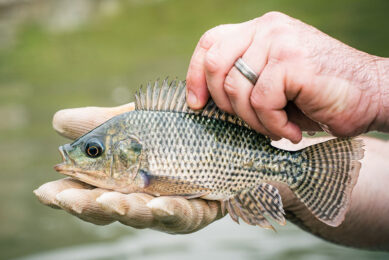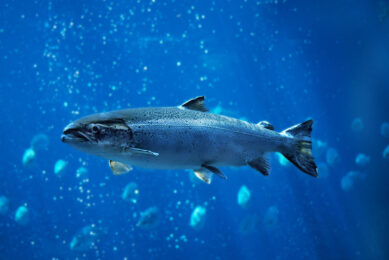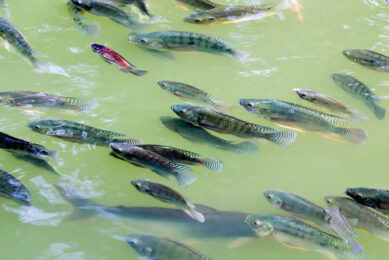Nearly half of all fish eaten today farmed, not caught
Nearly half the fish consumed as food worldwide are raised on fish farms rather than caught in the wild, says a new report from FAO. “The State of World Aquaculture 2006” was presented recently to delegates from more than 50 countries attending the biennial meeting of the FAO Sub-Committee on Aquaculture in New Delhi.
 Since 1980 the fish consumed by humans that came from aquaculture has
Since 1980 the fish consumed by humans that came from aquaculture hasincreased from 9% to 43%, the report shows. That equals 45.5 million tonnes of
farmed fish, worth US$63 billion, eaten each year. Currently, freshwater and
marine capture fisheries produce 95 million tonnes annually, of which 60 million
tonnes is destined for human consumption.
Globally, consumer demand for fish continues to climb, especially in
affluent, developed nations which in 2004 imported 33 million tonnes of fish
worth over $61 billion, 81% of all fish imports that year, in value terms.
But levels of captures of fish in the wild have remained roughly stable since
the mid-1980s, covering around 90-93 million tonnes annually. There is little
chance of any significant increases in catches beyond these levels, FAO says.
The agency’s most recent global assessment of wild fish stocks found that out
of the nearly 600 species groups it monitors, 52% are fully exploited while 25%
are either overexploited (17%), depleted (7%) or recovering from depletion (1%)
and 20% are moderately exploited, with just 3% ranked as underexploited.
FAO report estimates that an additional 40 million tonnes of aquatic food
will be required by 2030 – just to maintain current levels of consumption. The
only option for meeting future demand for fish is by farming them. There’s just
one question.
Can aquaculture actually deliver?
The jury is still out, according to FAO report. “Aquaculture could cover the
gap between supply and demand, but there are also many forces which could pull
production in the opposite direction, making it difficult for the industry to
grow substantially enough to meet demand in the decades to come,” it notes.
Aquaculture has been experiencing a boom since the mid-1980s, sustaining a
growth rate of around 8% per year. Today it continues to expand in almost all
world regions, with the notable exception of sub-Saharan Africa.
But FAO is concerned that momentum could taper off if governments and
development agencies don’t adjust their policies to respond to emerging
challenges that threaten to damper the sector’s future growth.
One serious bottleneck, says FAO, is the lack of investment capital for
producers in the developing world. Another is a shortage of land and freshwater
for use in aquaculture. Rising energy costs also pose a problem, and
environmental impacts and questions of product safety continue to require
attention.
 |
Let them eat…?
The agency’s report also points to doubts regarding future supplies of
fishmeal and oil, used to feed carnivorous cultured species, such as salmon,
grouper and sea bream. Since 1985, world production of fishmeal and fish oil –
manufactured using fish which are caught in large volumes but which are not
consumed by humans – has stabilized at 6 to 7 million tonnes and one million
tonnes, respectively.
While the vast bulk of fishmeal is used for livestock feed, chiefly by the
poultry sector, aquaculture now accounts for 35% of the world’s fishmeal supply.
So as aquaculture’s fishmeal needs grow, competition with terrestrial livestock
for a limited resource will intensify, with ramifications for both price and
availability. Key to resolving the dilemma will be continued
progress in improving the efficiency of feed formulations – reducing the
amount of fishmeal they contain – and coming up with adequate vegetable-based
additives.
“We need to start planning now for handling these challenges, because
aquaculture is crucial to the fight against global hunger,” Ichiro Nomura, FAO
Assistant Director-General for Fisheries, says. “It offers a source of food that
is rich in protein, essential fatty acids and vitamins and minerals. And it
offers a way to boost development by providing jobs, improving people’s incomes,
and increasing returns on natural resource use. We must ensure that the sector
continues to expand, sustainable, to provide more people with food and income,
especially in areas like sub-Saharan Africa and Asia, where hunger and poverty
prevail”. (FAO)
Source: Feed Tech magazine Volume 10 nr.
9
Join 26,000+ subscribers
Subscribe to our newsletter to stay updated about all the need-to-know content in the feed sector, three times a week. Beheer
Beheer









 WP Admin
WP Admin  Bewerk bericht
Bewerk bericht